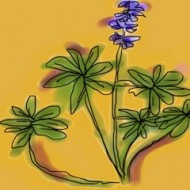The Dry Garden: A three-acre labor of love called Arlington
As beautiful as private landscapes can be, and they can be stunning, none can match the poetry, joy and solace of a public garden done right. As proof, look no further than Arlington Garden in Pasadena. Here, since breaking ground on the 3-acre site five years ago, neighbor Betty McKenney has seen just about every kind of human interaction.
“We have people who meditate and pray,” said McKenney, left. “We have counselors and young people from a local clinic, some of whom are pretty troubled. Certainly there are schools and Scout programs. People bring their computers, or they read. They walk dogs. We see engaged couples getting photographed. Other photographers work on catalogs with their models. Last time it was a little bit risque. Some of those girls had really long legs. We see couples — 70, 80 years old — holding hands walking through the garden. I saw a …
The Dry Garden: Lili Singer
On March 5, what has amounted to a year-long birthday party will conclude with a gala at Descanso Gardens. Everyone with $75 and a love of native plants is welcome to attend a shindig marking the 50th year of the Theodore Payne Foundation for Wildflowers & Native Plants.
Celebrating the stoic glory of our native flora is a great cause, but this isn’t just about the birthday of an organization affectionately called Teddy Payne by KPCC radio host John Rabe. It’s not even about the English seedsman for whom the foundation is named. It’s about the foundation’s special projects coordinator, the homegrown horticulturist Lili Singer, who turns 61 on Saturday and whose nearly four decades of garden teaching in Southern California has much to do with the rise of not only the Theodore Payne Foundation, but also the Los Angeles County Arboretum & Botanic Garden, the Southern California …
The Dry Garden: Dead in the pot
Planting season in Southern California is rarely busier than midwinter, when nursery lots crammed with Christmas trees give way to displays of fruit trees and roses. If you’re haunting stores to select an apricot tree, a flowering bramble, a hedge or even a specimen tree, plant pathologist Jim Downer has a message for you: “Good gardening starts with good plant selection.”
By which he means: If the stock you find is root-bound, walk away.
Click here to keep reading The Dry Garden in the Los Angeles Times.…
The Dry Garden: Better than beautiful
The former librarian at the Los Angeles County Arboretum & Botanic Garden doesn’t remember exactly when the visitor wandered into her office and let drop that he was a descendant of George Engelmann. What Joan De Fato does remember is telling him that there was a grove of rare oaks on the site that had been named for his ancestor.
You don’t have to be a descendant of one of the fathers of American botany to share in what De Fato recalls as his pleasure and amazement. The arboretum’s grove of Quercus engelmannii, pictured above, is one of the last local stands of a native tree once so common to the foothills that an alternate common name is the Pasadena oak.
The first thing that strikes you upon reaching this group of roughly 200 trees is how much more animated it is by birds, butterflies and scampering lizards …
The Dry Garden: “Capacity” = good nurseries
The potential for gardeners here to conserve water while glorying in the California experience is as big as the state. Yet most of us don’t seize it. According to local water managers, the problem is “capacity.”
By capacity, they refer to the ability of chain home improvement stores to stock drought-tolerant native and Mediterranean-climate plants alongside water-hungry turf. Building native-plant capacity in big-box stores is tough. The inventory get watered to death by untrained staff, who don’t know what the plants are much less what they need. So “capacity” tends to be code for “forget about it” when the subject of water conservation comes up.
Well, water managers, reality check. Nursery capacity for native plants is increasing, albeit slowly. A network of independent specialist nurseries is emerging. Most of these not only have trained staff to sell native plants but also offer courses on how to design gardens and how …
« go back — keep looking »

